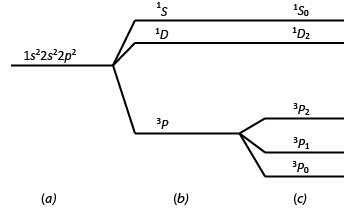ADDENDUMBenzene RingOne of the great puzzles of organic chemistry is the bonding structure of benzene (C6H6). X-ray studies have determined that all sides of the carbon hexagon are equal, hence all interior angles are equal. Carbon provides four electrons for valence bonding. If we use a double bond to each adjacent carbon atom on each side, then no electron for the hydrogen valence bond is left. If the valence electron is used for hydrogen then there is a shortage for double bonding of adjacent carbon atoms. This would result in differing interior angles, which are not found. Pauling, in his book The Nature of the Chemical Bond, suggested a sharing arrangement for the electrons, this idea developed into RVB or resonance valence bond theory. The electrons have no definite locale, but resonate in some manner between all the carbon atoms. This became strictly a quantum attribute of the atom. However, Nancy Cartwright in her book How the Laws of Physics Lie, raises the question of the ground state of carbon. She quotes Albert Messiah's, Quantum Mechanics [2] to the effect that carbon has five distinct energy levels, yet current quantum models do not adequately account for this.
This raises the question whether the benzene ring bonding problem is related to the five separate and distinct energy levels that Messiah noted? If we use the Circular Model of the Atom, then the positive pole resolves the fifth energy level problem that Messiah cites (four electrons and the positive pole of the dipole). This then changes the benzene ring problem. The positive pole (in the Circular Model) bonds with the negative dipole of the next adjacent carbon atom. Then the first electron in the outer shell next to the positive dipole bonds with the last electron in the outer carbon shell nearest the negative dipole. This leaves two electron's left. This is where the hydrogen bond occurs. Hydrogen is quite unusual in that it has an exposed proton nuclear structure. The second electron of the carbon outer shell is in a 1S0 state with a subshell closure at that point. That particular electron coupled with the subshell closure behaves like a hole or positron position. Therefore, the second and third carbon electrons in the outer shell bond positive to negative and negative to positive, resulting in a very strong hydrogen bond. They do not annihilate because of the different mass and fields involved. [1] Tarasov, L., 1986. Symmetrical World. Moscow: Mir, p. 52, emphasis added. [2] Messiah, A., 1961. Quantum Mechanics. Vol II. Amsterdam: North Holland Publishing Co. p. 703. [3] Cartwright, N., 1983. How the Laws of Physics Lie. Oxford: Clarendon, pp. 67-69.
|
 |
- Home
- The Circular Model
- Quantum Charts
- Model Physics
- Part I: supporting evidences
- introduction
- Pauli's exclusion principle
- dipole magnet
- unique electron flip
- polarity and anomalous angular momentum
- lanthanide contraction
- Stern-Gerlach
- electron tunneling
- discreteness
- electronegativity
- Compton effect
- Dirac's equation
- symmetry
- gyromagnetic ratio
- nulcear shells
- Kaluza-Klein
- gravity
- magnetism and monopoles
- Heisenburg uncertainty principle
- missing mass
- Olbers' paradox
- Big Bang
- Part II: spectral evidences
- Part III: fine structure constant
- Part IV: superconductivity
- Part V: sub-atomic particle physics
- Part VI: summary
- Part I: supporting evidences
- Astrophysics
